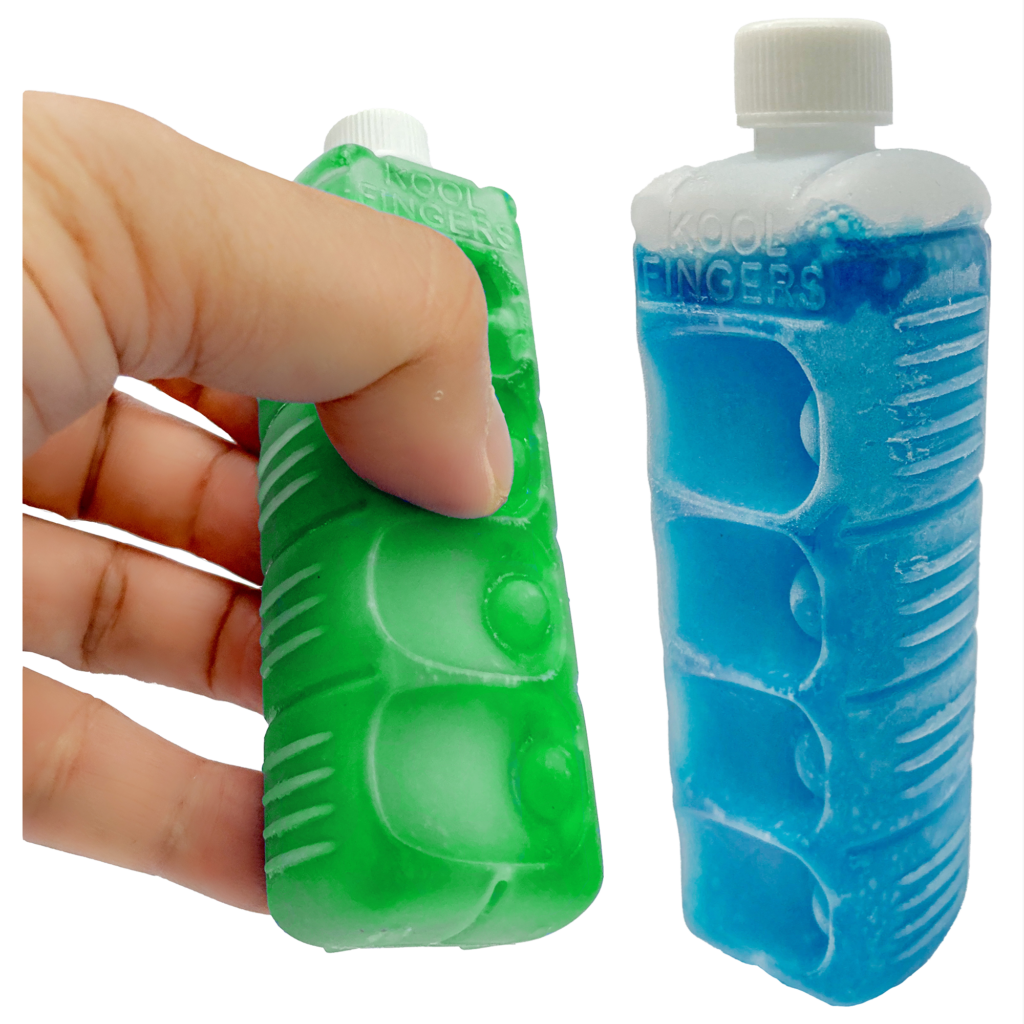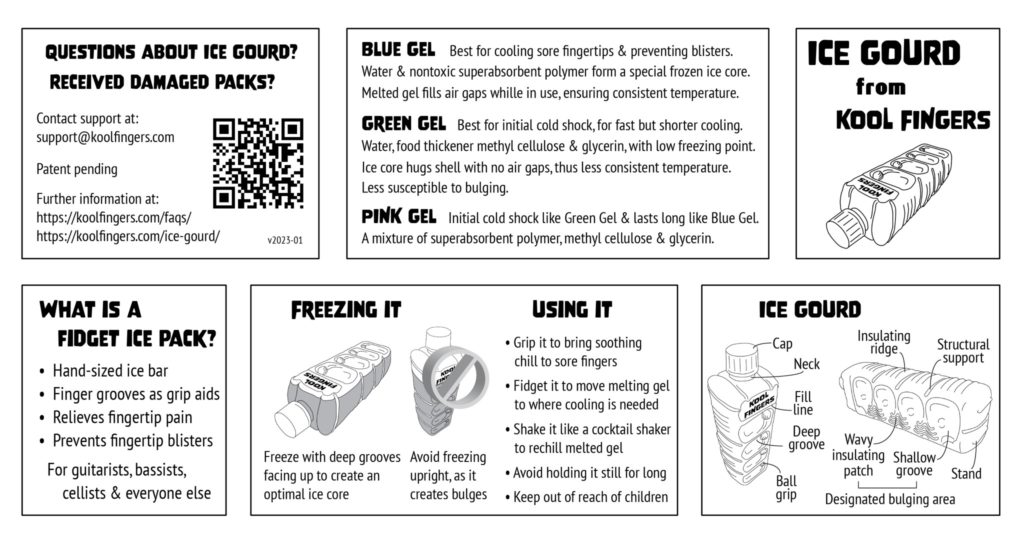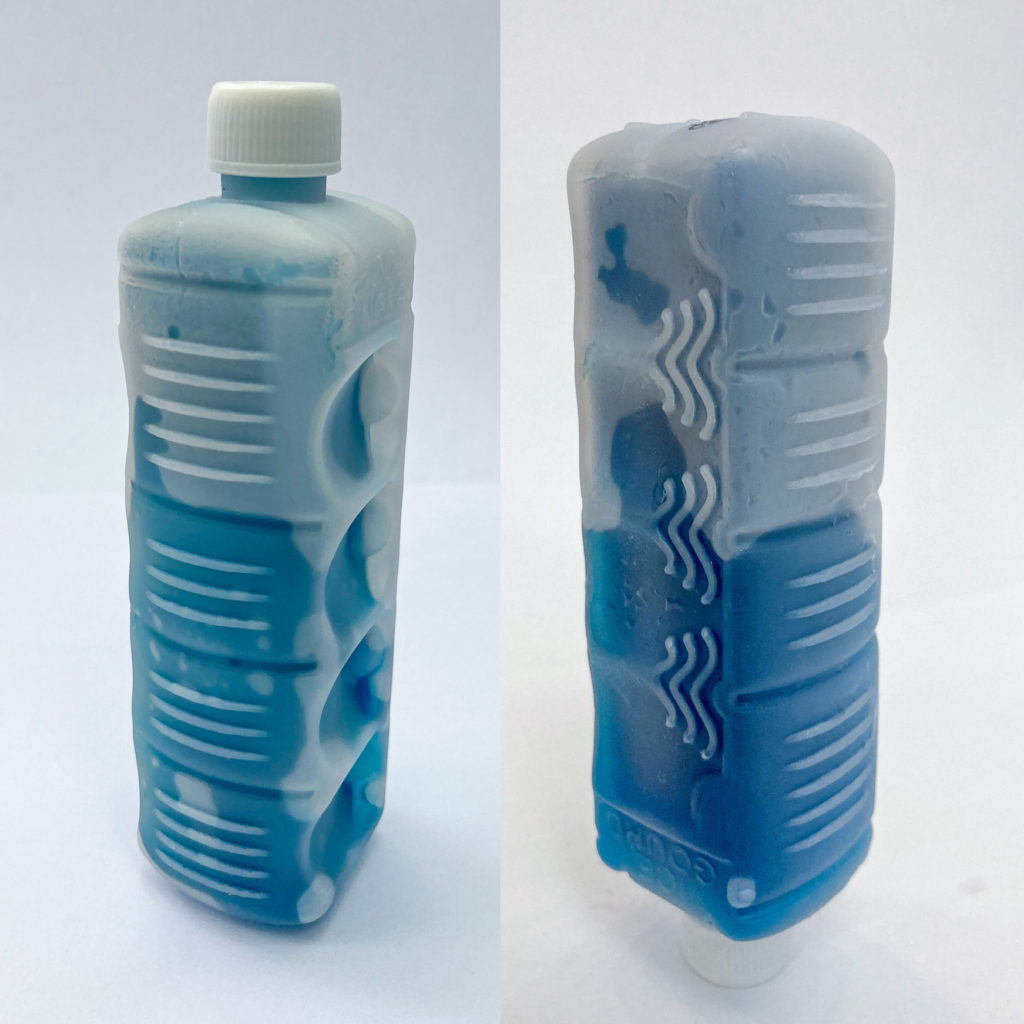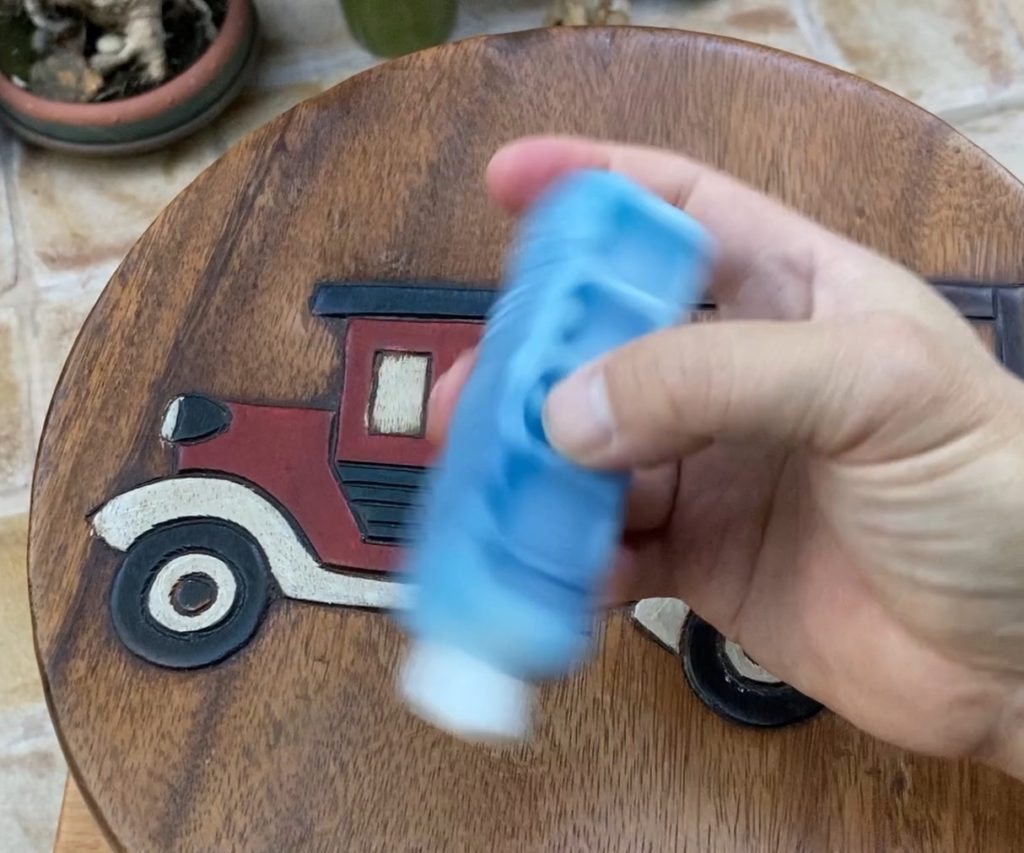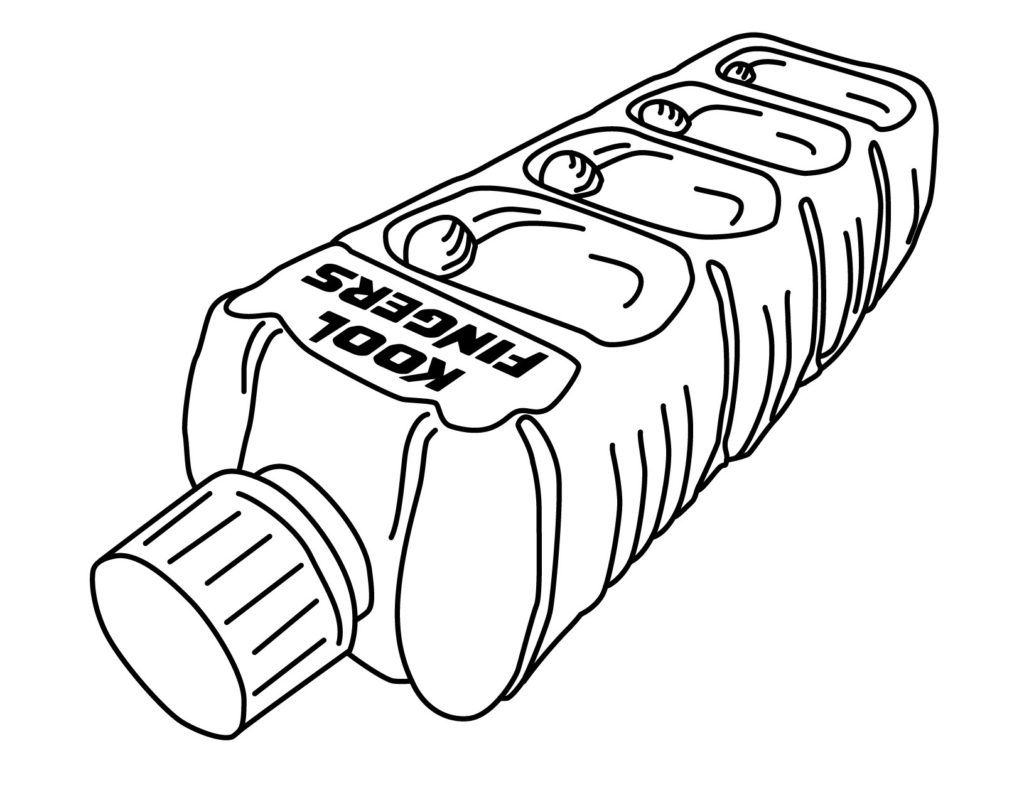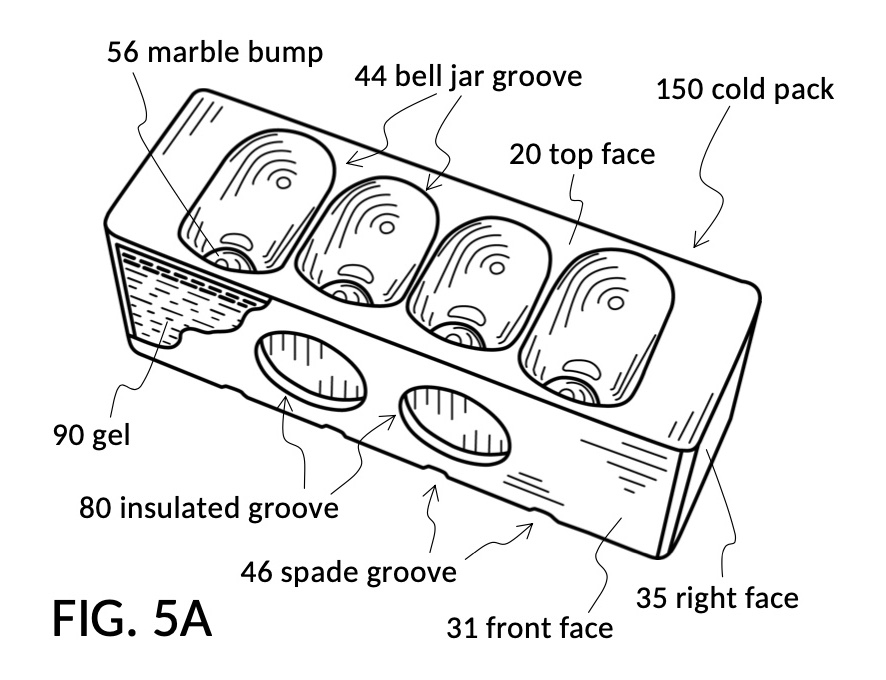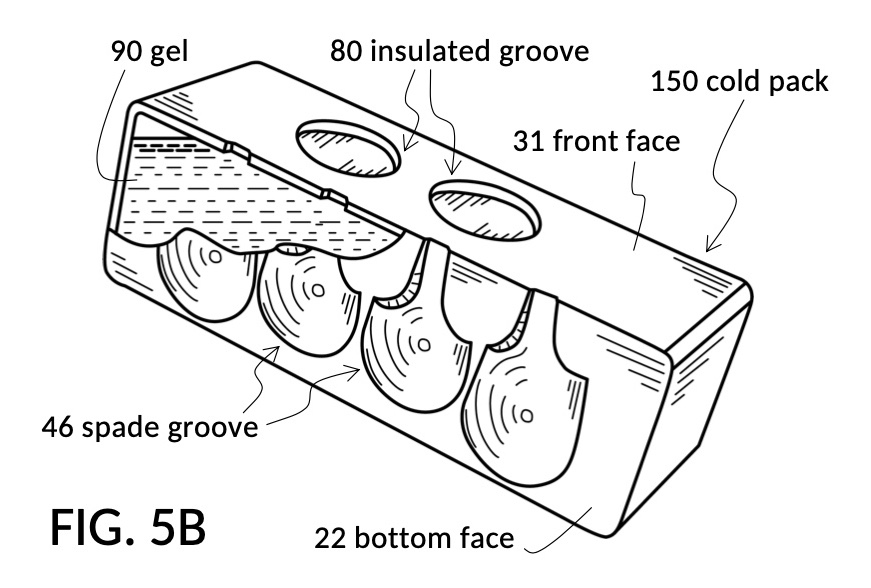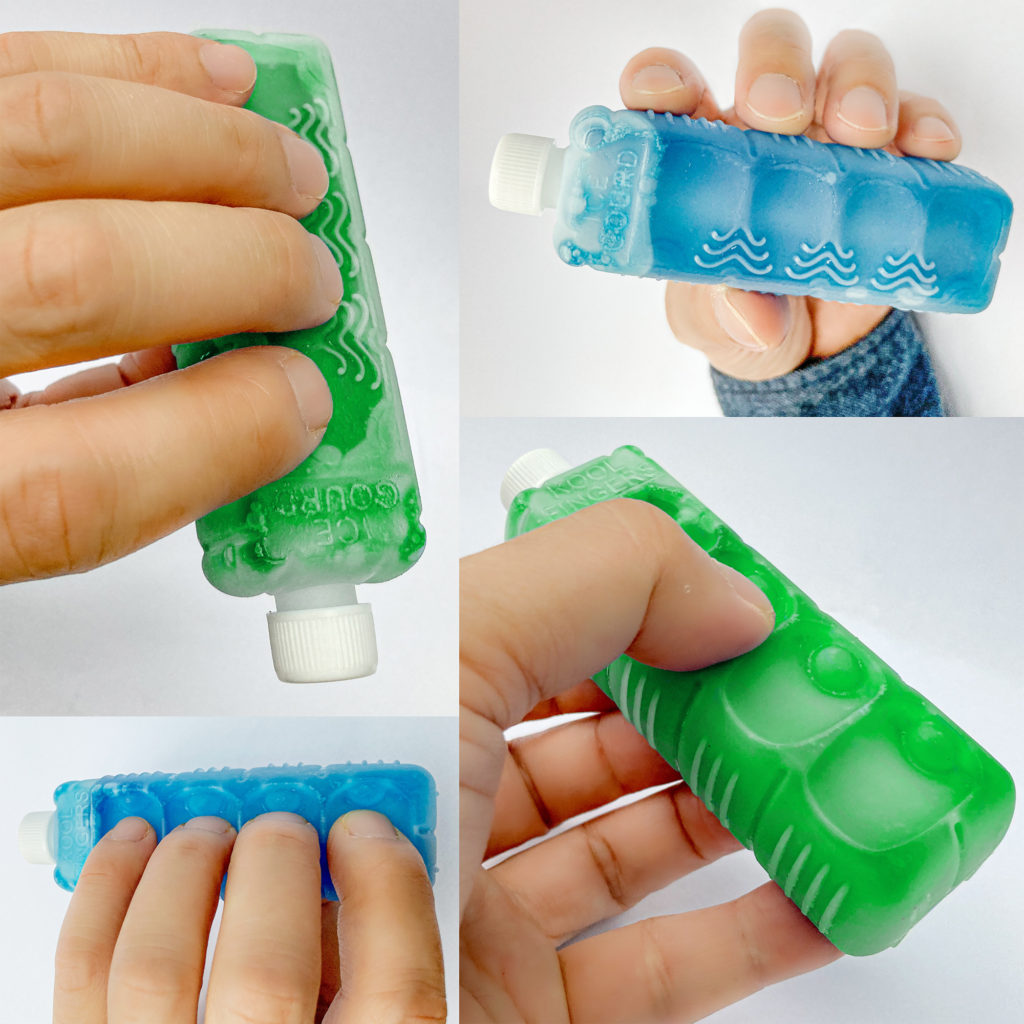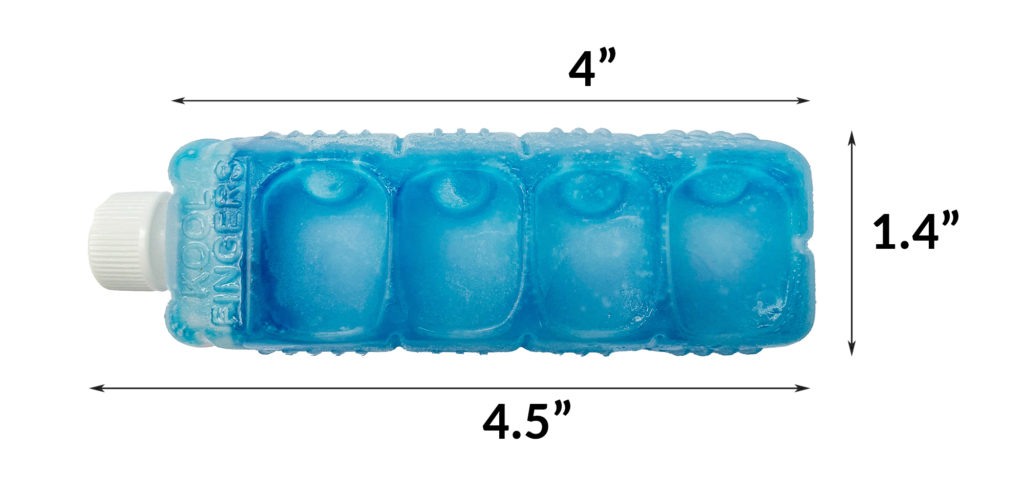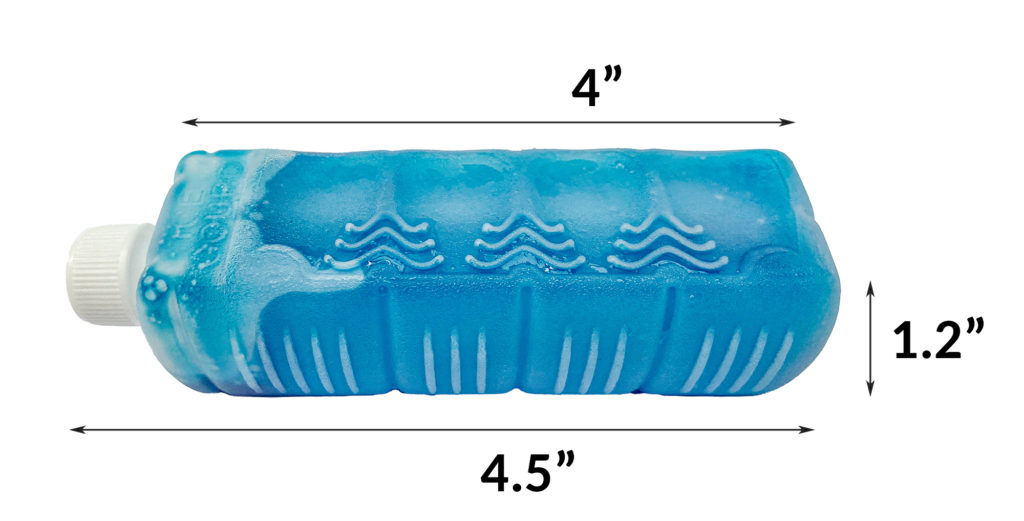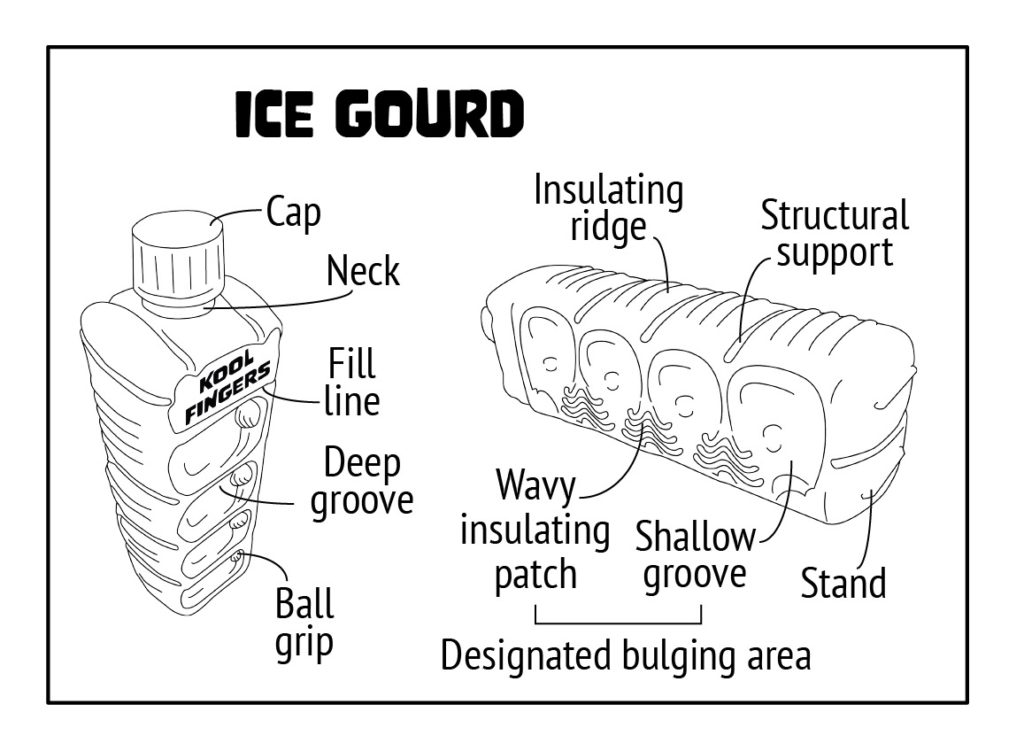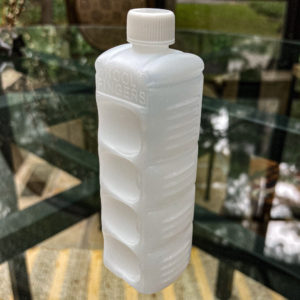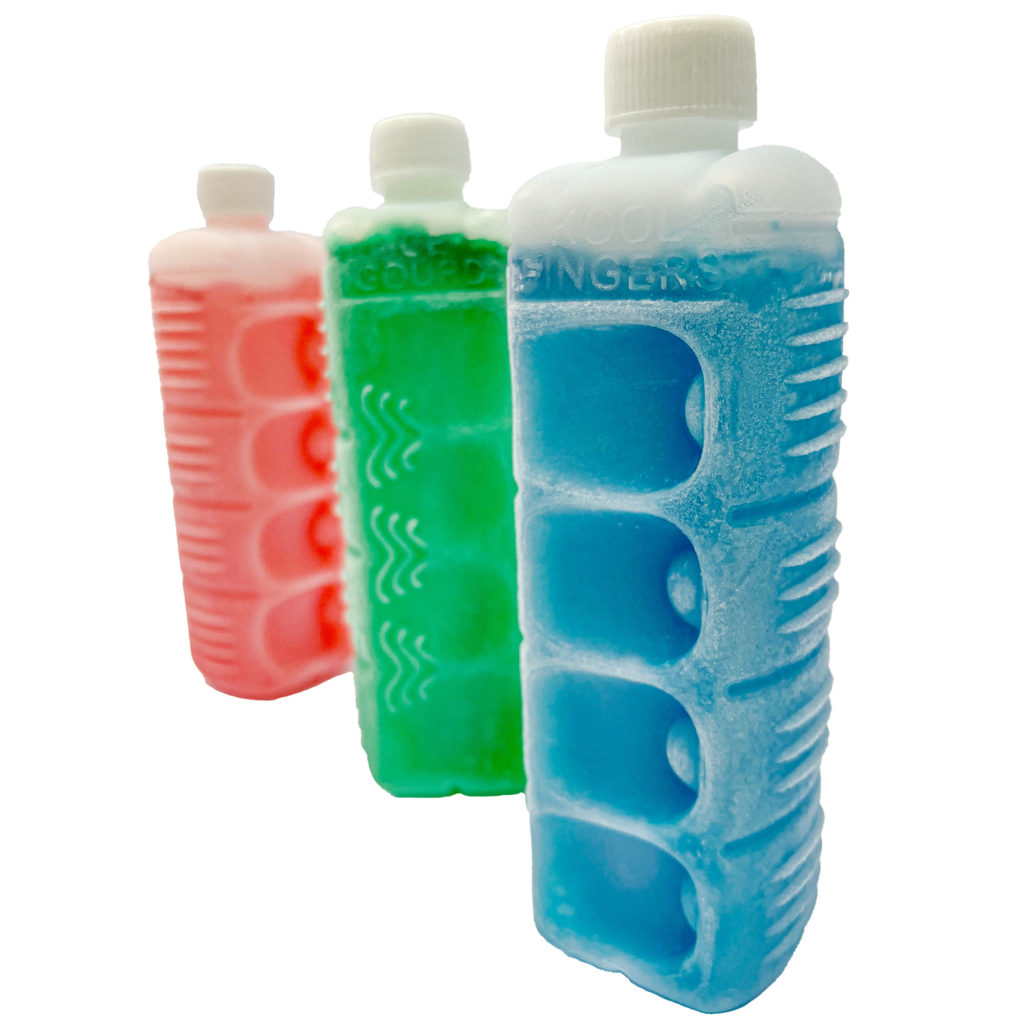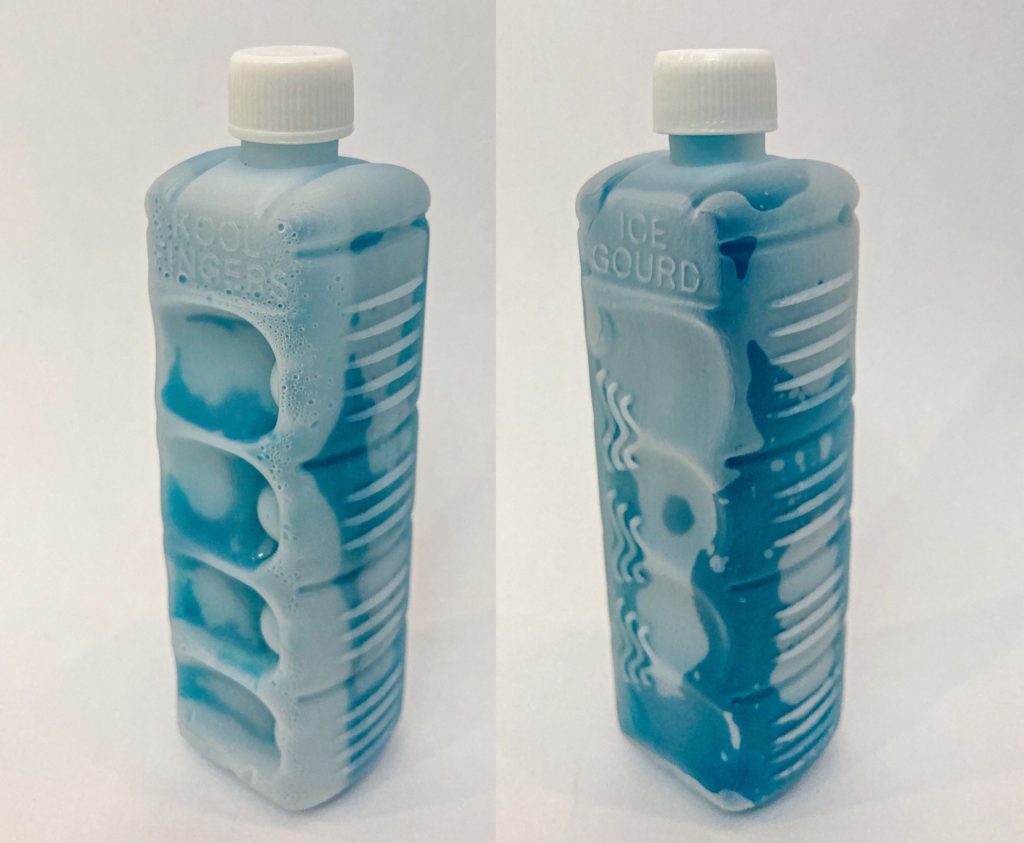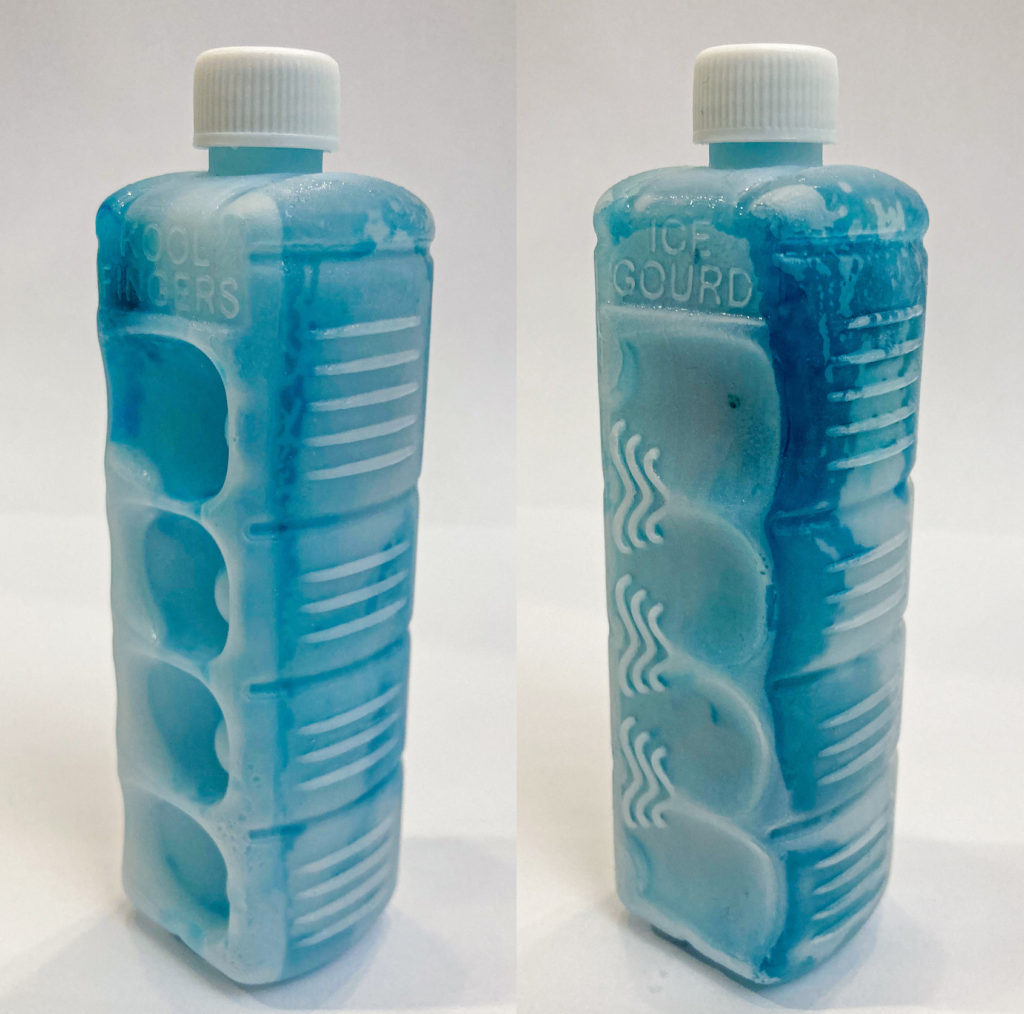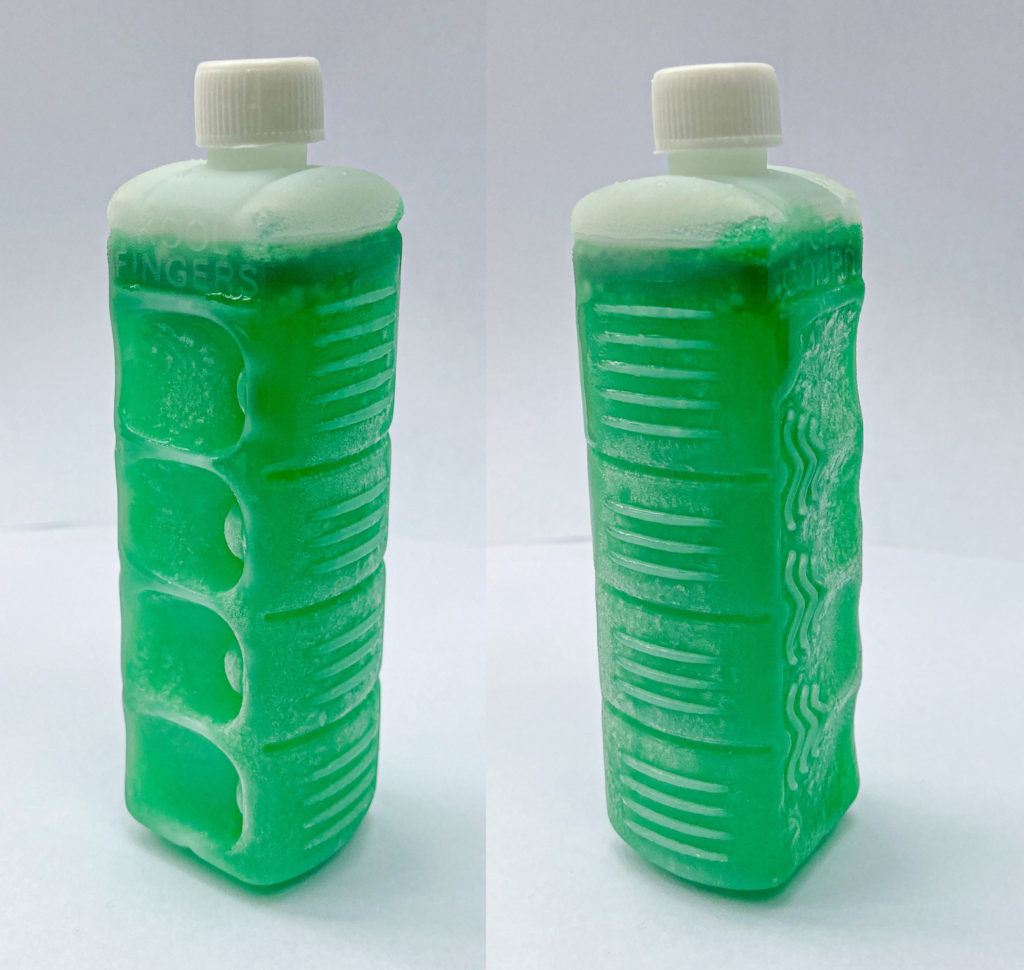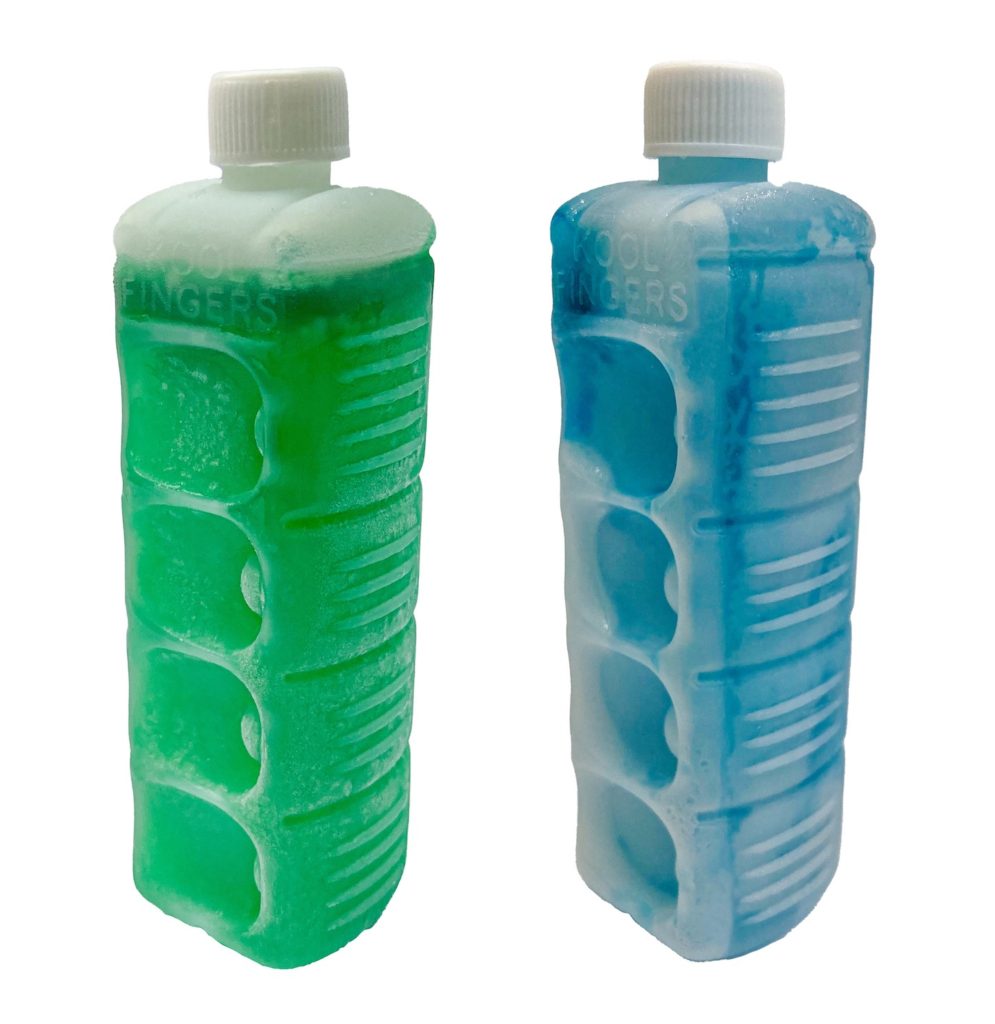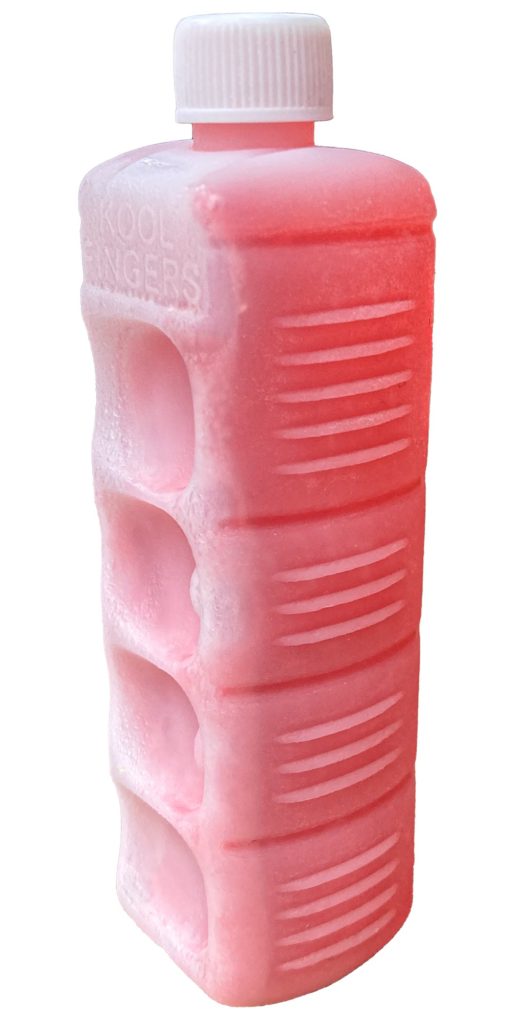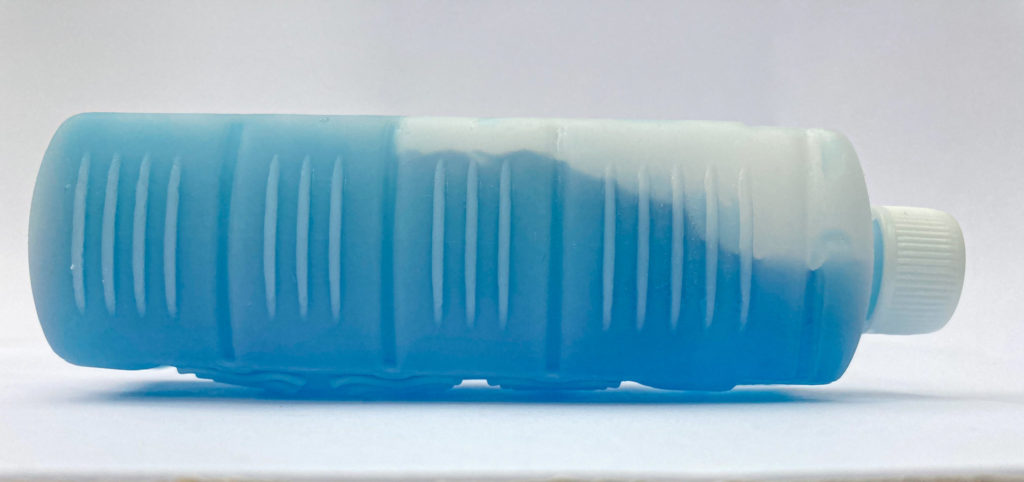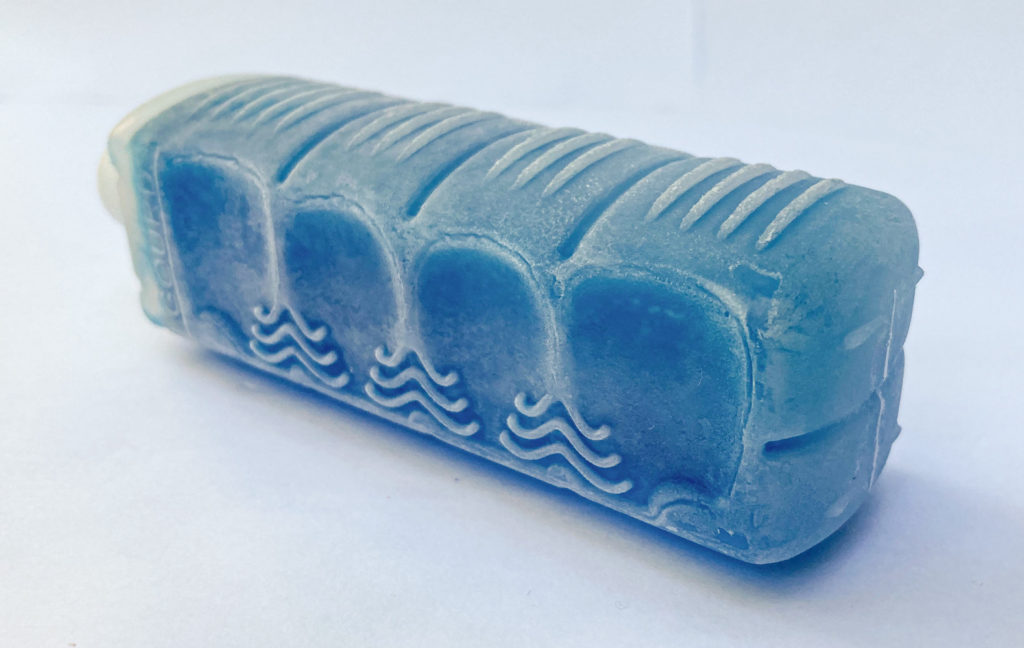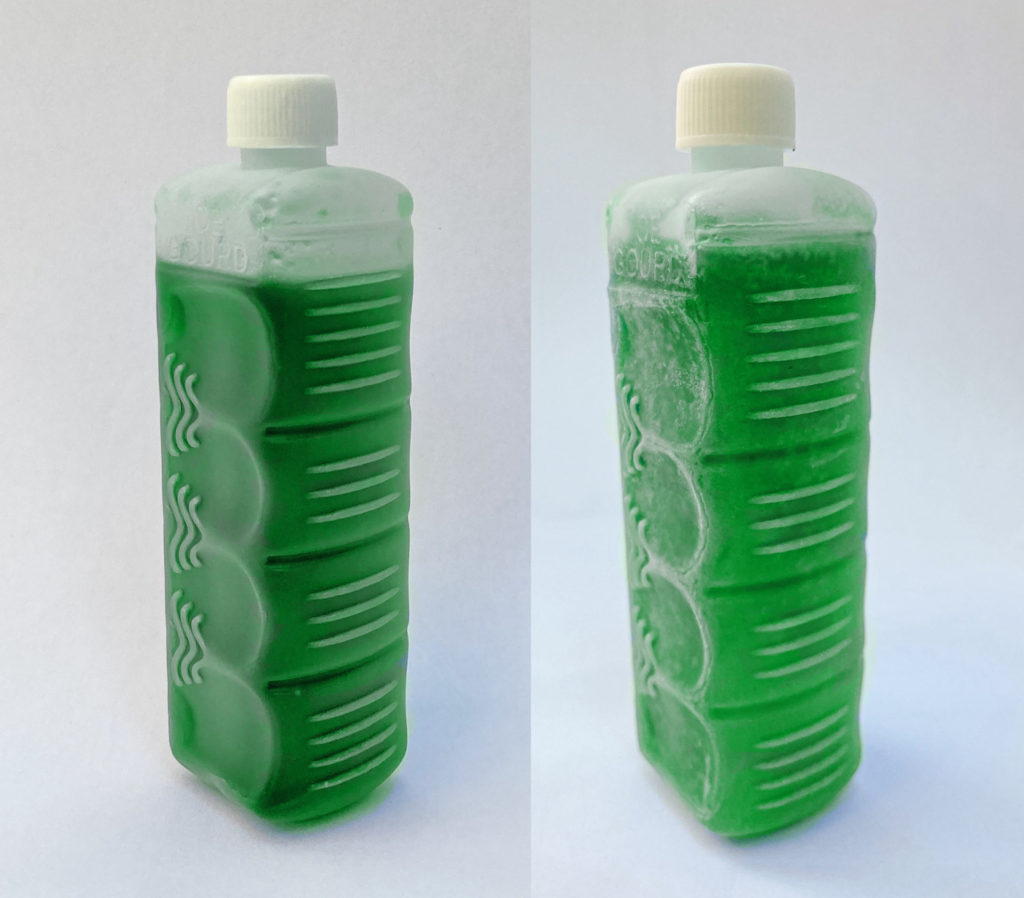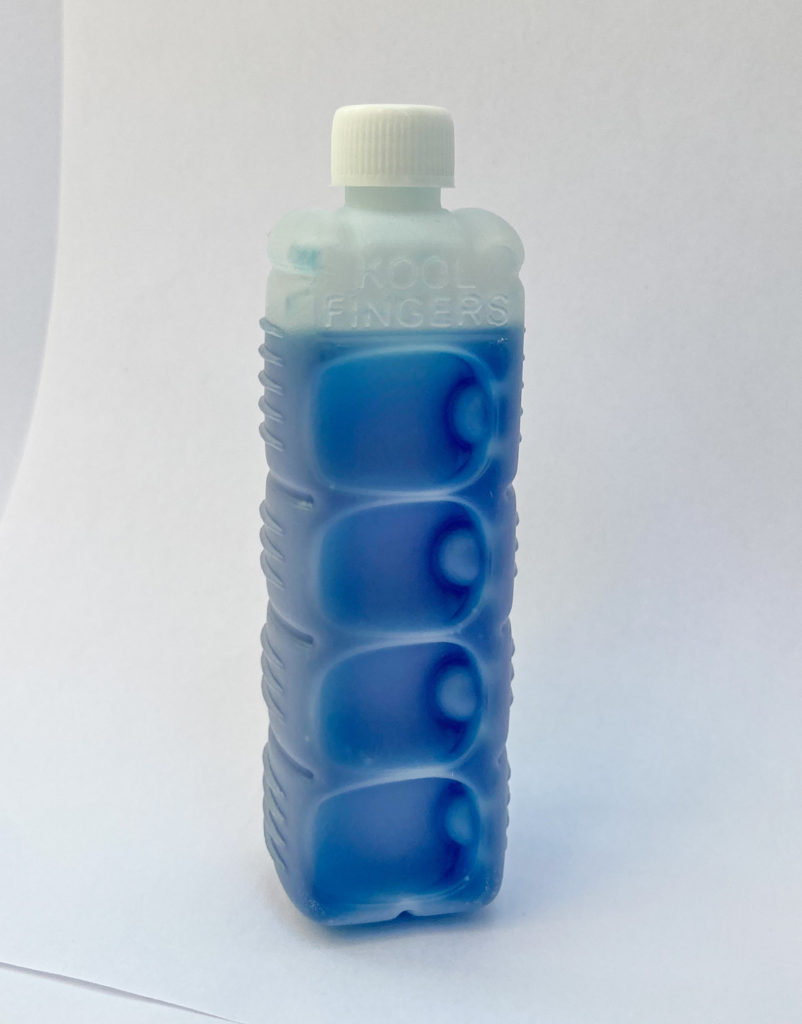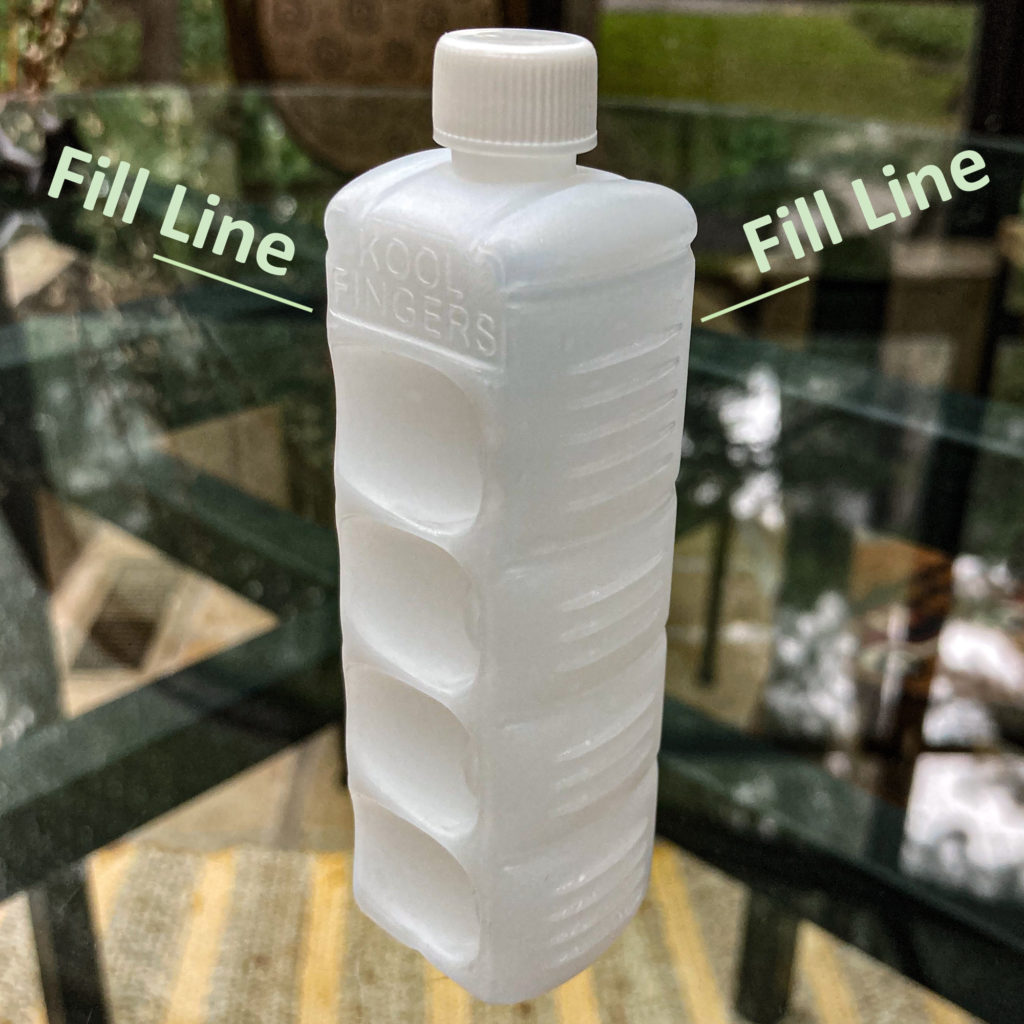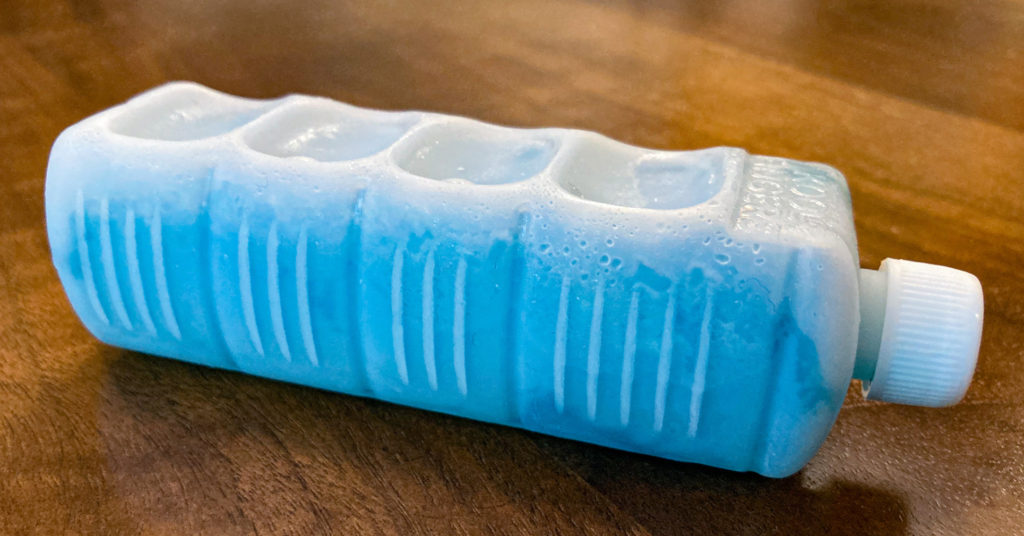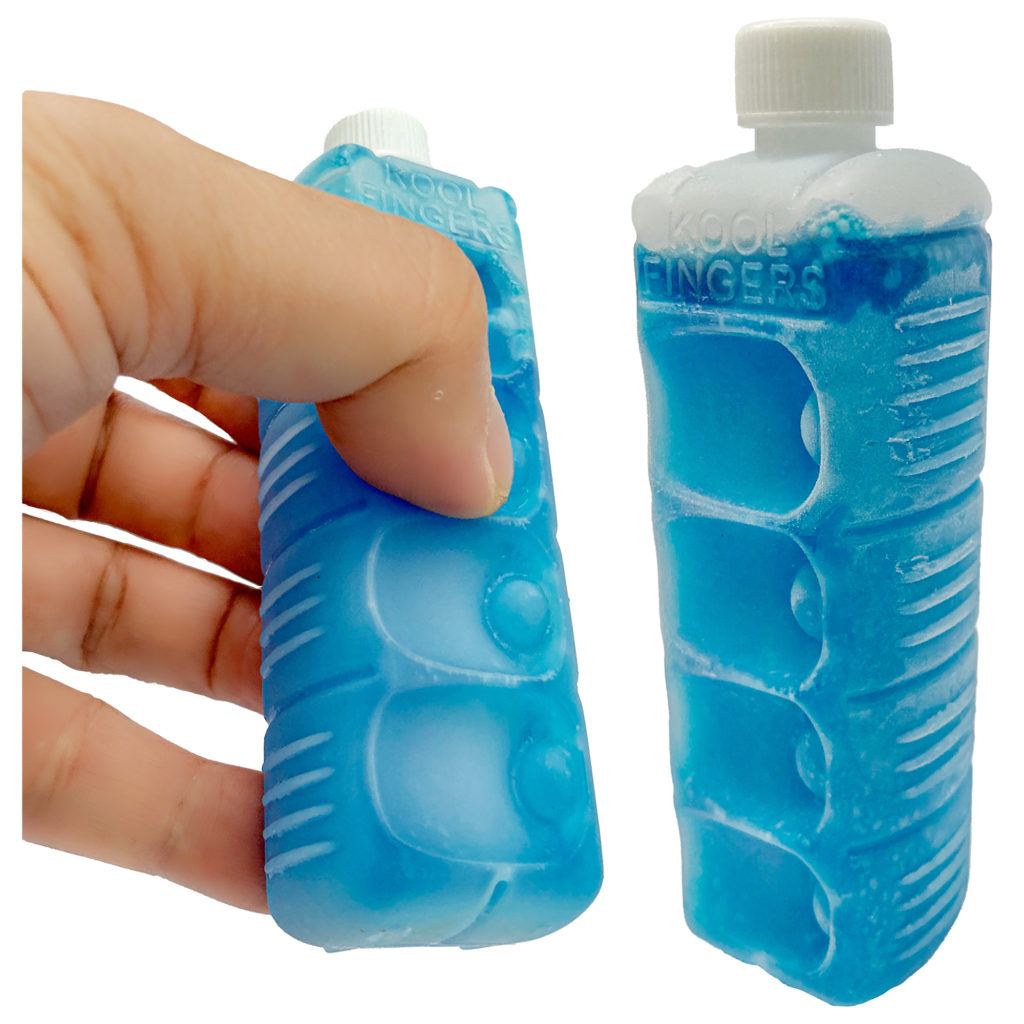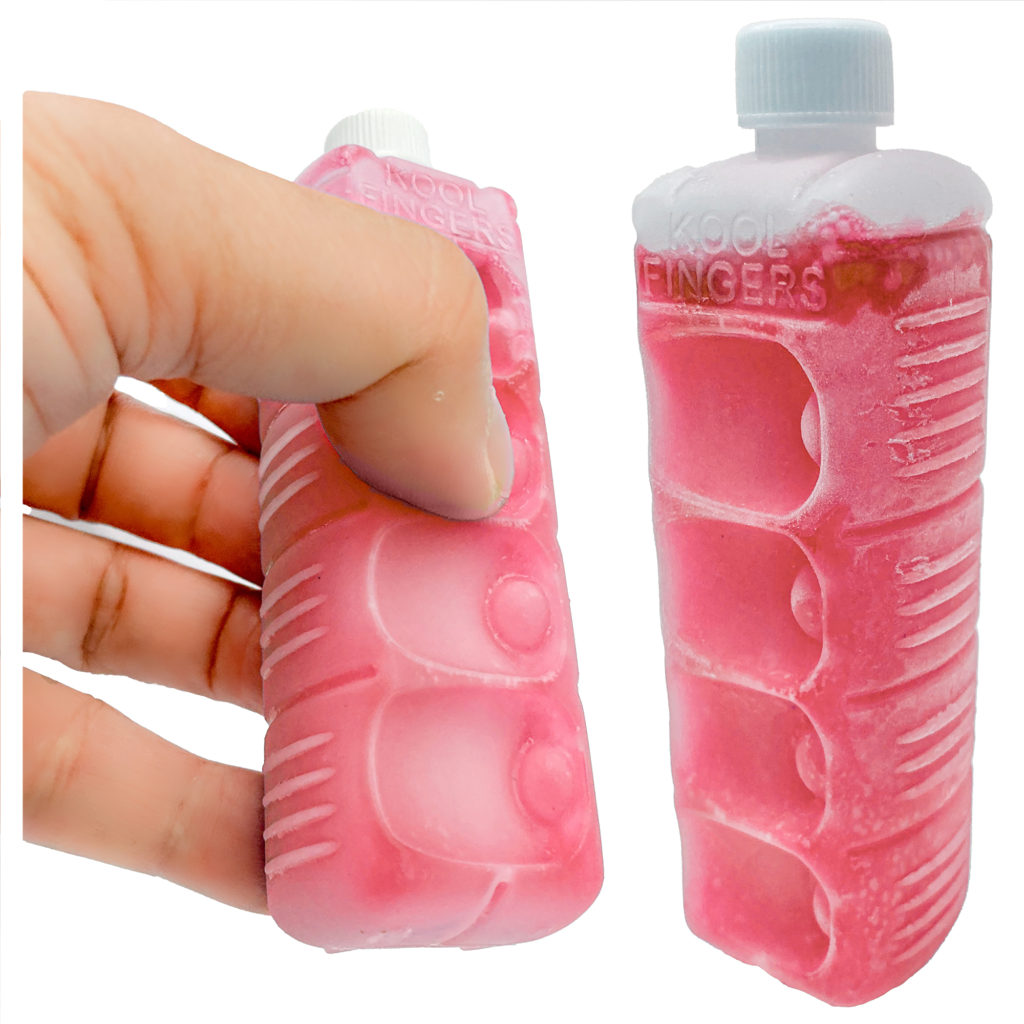Ice Gourd is the first fidget ice pack produced, ever. There has been nothing like it before. It addresses a need from musicians, sportspeople, craftspeople and chefs which were answered in the past with superglue and duct tape. It brings instant relief to your fingers from the pain your craft imposes on them. You will develop hardened skin instead of blisters. And you may find soothing cold from these ice packs comforting for relieving stress, even when not treating finger pain.
You can purchase them at our Kool Fingers Amazon store. If you have received damaged products, please head to the FAQs page.
Table of Contents
Fidgeting
The overall bar-shape of Ice Gourd is designed for fidgeting by a human hand. Bell jar grooves and spade grooves provide curves and edges so that fingers can firmly grip the bottle. Balls in bell jar grooves and wavy ridges by spade grooves further enhance tactile grips. More on these grip aids later.
As ice core melts during use, fidget and reorient the pack to direct gel flow, for selective cooling.
Shake the pack like a cocktail shaker, to chill flowing gel with ice core.
This is not a toy, and should not be used by children. Do not hold frozen ice packs with an unchanging grip for prolonged periods. Move fingers intermittently. You must continuously fidget an ice pack to avoid frostbites. Hold a pack by raised ridges when not seeking cooling effects. Put a fidget ice pack down when desired cooling is attained.
The Bottle
Ice Gourd is in essence a small bottle with finger indentations, or grooves, designed to be fidgeted by human fingers. Four finger grooves with deep indentations line one side of the ice pack. We call these bell jar grooves. There is a marble ball embedded at the bottom of each groove.
Four finger grooves with shallow indentations line the opposite side of the ice pack. We call these spade grooves.
As they say, no product design survives first contact with actual manufacturing process. Ice Gourd turned out more like a small water bottle than a rectangular bar.
Raised ridges found on two sides provide semi-insulated patches for fingers to grip a fidget ice pack, when a user is not seeking cooling effects. Raised wavy ridges in between spade grooves serve the same function. It provides refuge for the thumb and fingers when needed.
Ice Gourd measures 4.5″ x 1.4″ x 1.2″, and weighs 2.82oz. The cooling gel is only filled up to a prescribed fill-line. More on that later.
Cooling Gel
Pure water will do as cooling gel. You can refill any Ice Gourd bottle with pure water. It will still help relief finger pain, and prevent finger blisters. But pure water has no color, and looks dull. We use food colorings to make our cooling gel interesting to look at. You can too. Two drops of any McCormick food coloring from your local supermarket will make water look interesting. However, pure water expands in non-optimal ways as it freezes, and does not have thawing properties that special cooling gels provide. Our various cooling gels are formulated to provide longer-lasting cold, compared to pure water.
Cooling and freezing behaviors of liquids is a fascinating topic. Check out our blog for discourses on different types of cooling gels. We’ll be posting updates on different types of gels over time. It may even inspire you to create your own formula for different purposes.
Following are specifications of different gel types.
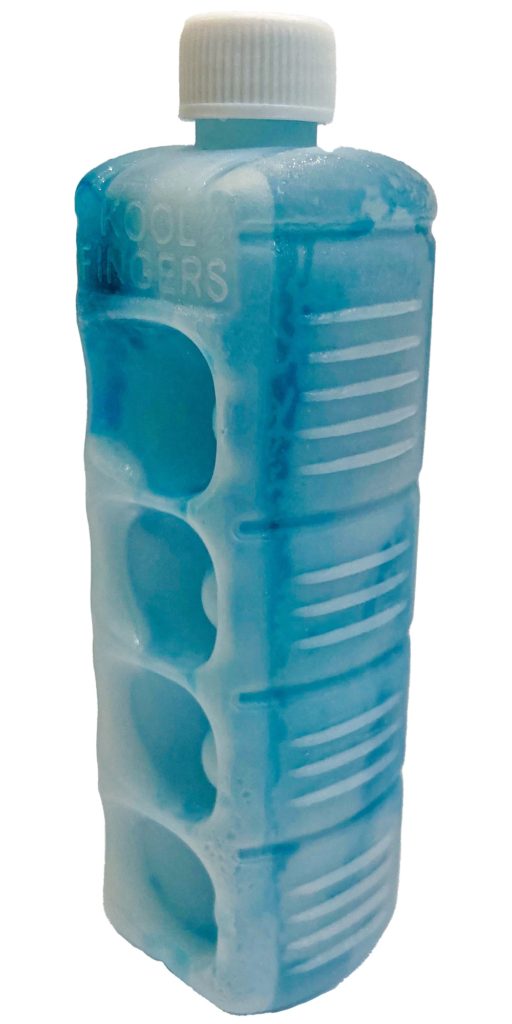
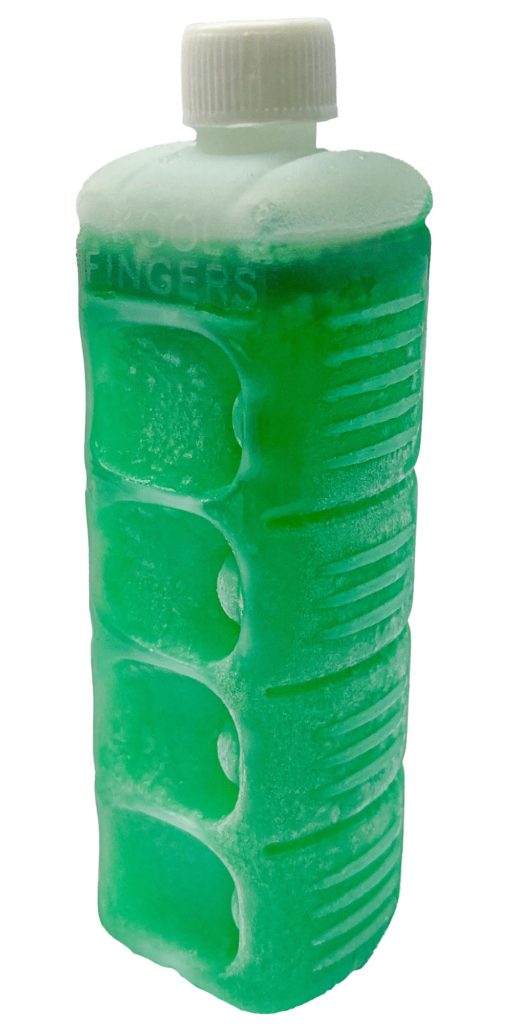
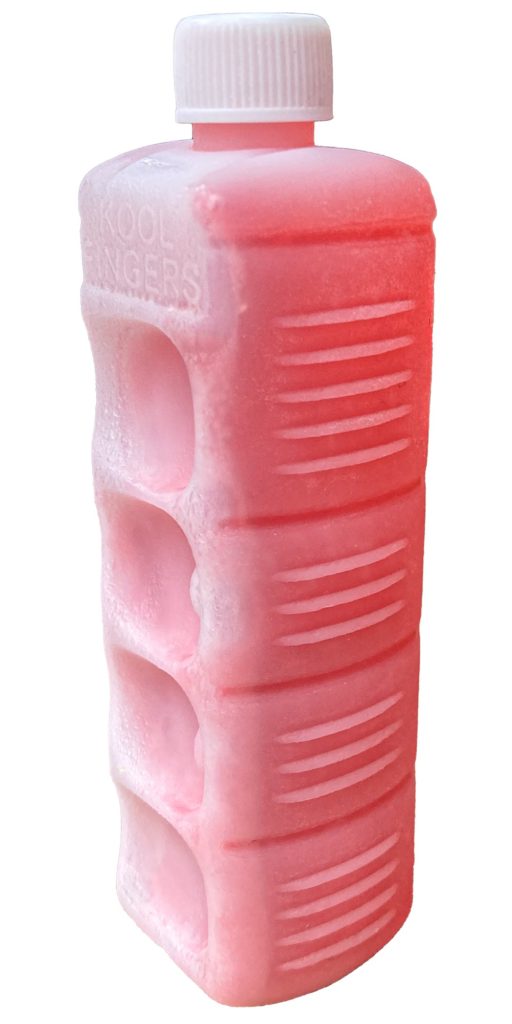
| Blue Gel | Green gel | Pink Gel | |
| Cooling agent | Nontoxic superabsorbent polymer (SAP) which turns water into a chunky gel, forming a special frozen ice core | Food thickener methyl cellulose (MC) dissolved in small amount of food-grade glycerin, and lowers freezing point of water | A 3:1 mixture of SAP and MC, providing advantages from both Blue Gel and Green Gel |
| How to freeze | Best frozen with deep grooves facing upward | Best frozen with deep grooves facing upward | Best frozen with deep grooves facing upward |
| Expected ice core | When repeatedly refrozen, a solid ice core leaves air gaps under shell which is filled by melted gel while in use, for consistent groove temperature, and satisfactory thumps when shaken | When frozen, a mushy ice core hugs inner surfaces of shell leaving no air gaps, thus provides maximum cooling on groove surfaces when first removed from freezer | A solid ice core like Blue Gel with satisfactory thumps when shaken, but without air gaps thus the initial cold shock like Green Gel |
| Bulging behavior | Susceptible to slight bulging in the designated bulging area (the wavy insulating ridges), if the ice pack is frozen upright. Instead, freeze the pack with deep grooves facing upward. | Much less susceptible to bulging compared to Blue Gel | Slightly less susceptible to bulging compared to Blue Gel |
| Best for | Treating sore fingertips to forestall blister formations | Providing initial cold shock for fast but shorter cooling | Initial cold shock like Green Gel, and lasts almost as long as Blue Gel |
Blue Gel
At this time, we make available three types of cooling gel. The first one is colored blue, and is basically water and a sprinkle of superabsorbent polymer at a concentration of 400:1. The polymer is known as SAP in the industry. Specifically we use plain sodium polyacrylate commonly used in ice packs. It is nontoxic and environmentally-safe.
Through long series of experimentations, we found that water-saturated SAP chunks cling to one another as a fidget ice pack is frozen. Blue SAP gel freezes and expands into a solid ice core gradually, shifting and scraping like a mini-glacier against irregular inner surfaces of an ice pack. This results in air gaps between some inner surfaces and the final ice core.
These air gaps become more pronounced as an ice pack is half-melted in regular uses, and repeatedly refrozen from its half-melted state.
The ice core is extremely cold when first removed from a freezer. Bottle surfaces in direct contact with the ice is thus colder than usually required. Air gaps dampen the initial coldness of said surfaces. As the surface warms up, and ice core melts, viscous liquid then gradually fills these air gaps, and provides a moderated cold transfer from the ice core to surfaces.
You control the cold transfer by shaking the bottle. With the Blue Gel, a solid ice core remains in the middle of melted gel, until the very last moment of the thawing process. Every shake ends with a satisfactory thump of the core.
Air gaps between surfaces and the ice core ensures a constant cooling temperature at external finger grooves. Blue SAP gel is thus great for treating sore fingertips to forestall blister formations.
Green Gel
Some use cases call for a second type of gel. The Green Gel is again basically water. This time it contains food-grade thickener methyl cellulose (MC) at a concentration of 200:1. A small amount of food-grade glycerin is used to dissolve MC in water. These are both ingredients used in cooking, and therefore safe.
As most of Green Gel freezes, even the last drops of unfrozen Green Gel remain flowing, filling nooks and crannies. Green Gel leaves no air gaps between its frozen core and inner surfaces of a fidget ice pack.
This freezing behavior a stark departure from Blue Gel. Both gels are viscous, in their own ways. The Blue Gel is free-flowing liquid with gelatinous chunks . The Blue Gel as a whole appears viscous, because these chunks get in the way of one another. Green Gel on the other hand is uniformly viscous. Its gel can and will flow into every nook and crevice, given time.
Green Gel has a lower freezing point than water and Blue Gel. Green Gel presents finger groove surfaces much colder than Blue Gel or pure water, by at least 10°F, when it is first removed from a freezer. But this initial cold shock does not last forever.
Green Gel loses its coldness faster than Blue Gel, and eventually becomes completely melted sooner than Blue Gel. Green Gel appears to resist melting for a while, and when shaken feels like a solid block. But when it melts, it collapses. The entire gel become mushy, and no single solid ice core is felt when shaken.
Green Gel thus offers a colder initial shock for applications where constant cooling temperature at finger groove surfaces is not important.
Pink Gel
Pink gel is a mixture of blue and green ingredients. It is a 3:1 mixture of SAP-based Blue Gel, and MC-based Green Gel, providing advantages from both Blue Gel and Green Gel. The result is a solid ice core like Blue Gel with satisfactory thumps when shaken, but without air gaps thus affording an initial cold shock like Green Gel. It is slightly less susceptible to bulging compared to Blue Gel. And lasts almost as long as Blue Gel.
Bulges
Blue Gel provides long-lasting and constant cooling, at the expense of a tendency to cause bulging. Sometimes the shifting and scraping of a cooling SAP gel becomes non-agreeable with an irregular inner surface. It gets stuck, and liquid that freezes around it then causes a part of an ice pack to swell.
Blue Gel is especially susceptible to bulging when frozen in the upright position, with the bottle cap at the top.
Green Gel is not as long-lasting as Blue Gel, and its groove temperature varies more drastically over time. But Green Gel is much less prone to bulging.
In any case, we have explicitly created a safe space to accommodate natural bulging behavior of ice. The spade grooves and the wavy insulation patches have been designed to provide bulge relief.
You can freeze an Ice Gourd in any orientation. As mentioned, we have designed spade grooves and wavy insulation patches to provide bulge relief. This face of the ice pack can safely bulge outward as a last resort. Some people may even prefer raised spade grooves for finger treatments.
However, we do recommend that an Ice Gourd be frozen with its bell jar grooves facing upward. There will be minimum bulging, regardless of whether Blue or Green Gel is used.
To remediate bulges, simply melt the ice core completely. Bulges will flatten themselves. And refreeze the fidget ice pack with bell jar grooves facing up.
Refilling
There are times when you need to refill a fidget ice pack. Perhaps a cap came loose and you lost some gel. Perhaps you want to experiment with your own cooling solutions. Follow a simple three step process described here, for best results.
First, you must not overfill a fidget ice pack. A generous volume of air is needed inside the bottle, in order to accommodate the expansion of water as it freezes. The air in the bottle is compressed, when a fidget ice pack is frozen. Compare the left picture of a fidget ice pack at room temperature, to the right picture of the same when frozen. Note how the frozen ice core has risen. Without an air cushion, the bottle will over-bulge and possibly break.
The fill-line is conveniently marked. It is the raise ridge underlining the brand name “KOOL FINGERS”. Do not fill beyond this line. The headspace is a required compression buffer.
Secondly, push the middle wavy patch inward, as you recap the bottle. This increases slightly the capacity of the bottle to cope with bulging.
Finally, freeze the pack lying on its spade grooves side. That is, leave bell jar grooves facing upward. This optimizes the expansion behavior of the ice core, preventing bulges.
Available in store
Ice Gourd fidget ice packs can be purchase at our Kool Fingers Amazon store. They are available in four variations at this moment.
Ice Gourd is warranted to be free of defects in material and workmanship for six months from date of original purchase. Warranty does not cover bulging which is a normal behavior. Warranty is voided if a pack is refilled with liquid not endorsed by the manufacturer, or overfilled beyond intended 66ml target volume.
Lastly, remember that a fidget ice pack is not a toy. Keep it out of reach of children.

